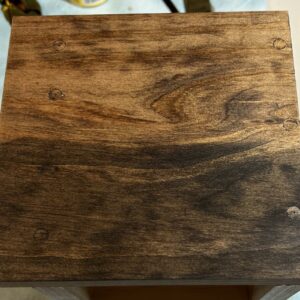Staining Wood – Is it supposed to be this splotchy?
I’ve built a miniature wood shelf unit with red oak to practice some techniques. I’ve been very disappointed in how splotchy the wood staining has turned out. (See images.) I understand why the board ends are so dark. I also used pine for the wood plugs on one side, so that difference was expected. This is red oak that was shrink wrapped and sold by a local “box” store. I used a power sander with 100 and then 220 sand paper to sand each side before applying the stain. I vacuumed up the saw dust and wiped them down with tack cloth. (Provincial stain for most of it. One portion was dark walnut stain.) The wood has not been varnished yet.
So, why is the stained wood so splotchy? Is this normal? A wood quality issue? Should I be using some kind of wood cleaner before staining? All advice appreciated.

















Replies
By the way, the wood face is only about 8" x 11" is size.
Looks more like cherry to me. For cherry, the splotching would not be unusual. However, what ever the species, I believe the fault is in the sanding. You should not skip grits. You should advance through all of the grits using each until you have removed the scratches left by the previous one. For some species (cherry being one. Oak not so much) blotching is the norm and a conditioner before the stain is recommended. Some have success with a light coat of thin shellac as a conditioner. Then, using a gel stain will sometimes help.
I would guess that is pine, not oak. Pine stains just this sort of splotchy way.
On my first project, before I knew anything about finishing a project, I used danish oil with stain in it. The project was made of pine. I about cried and gave up wood working. I didn't know any better. Multiple coats really helped even it out but still not the ideal finish to use on pine. If I were to do it over, it would be shellac as looks good on everything.
Looks more like pine than cherry, no way it's oak.
Probably Pine. I use it a fair amount stained. I *always* use a liberally applied pre-stain conditioner (G.F. oil products in my case) follow directions carefully. I dont have these issues. For end grain I will sand to 400 then apply 2 coats of 1# Seal Coat...taping off adjacent faces prior. This will typically keep end of boards from going way to dark.
Sorry, but yes. You must finish many times and learn much before successfully achieving a dark stain on relatively light toned wood.
Pre stain conditioner or sanding sealer/shellac would have been helpful.
Darker spots are basically just endgrain, so open straws ready to gulp up finish. Sanding finer with appropriate steps up will help.
Many samples, one at least.
The plugs might be red oak, but thats it.
Late to the party, but that is why you never buy wood from big box stores. Definitely not red oak, which stains beautifully by the way, but may be Alder or possibly Cherry. Many woods are tricky to stain, Maple being one of the worst, Cherry can be finicky and Pine is almost always going to splotch. There are many articles in FW about dealing with these issues but practice and experience is the best teacher, but even 40year pros struggle with splotchy stains sometimes. This is a leading reason I prefer to use woods that have natural colors that I want and use clear finishes more often than stains. Unless of course I'm staining red oak which almost impossible to screw up.
With face grain like that, it is changing direction in all ways, including up. This will expose end grain on the surface, having the same effect as on the end of the boards, which you already understand.
Simply lack of or uneven sanding, re-sand starting at 80 grit until the surface is even and all machining marks are removed then 120-150-180. If you are using oil stain, the finer you sand the lighter the color so you stop sanding at the grit that gives the desired color. Usually 120 or 150. If it’s water based stain, sanding can be as fine as you want.
I concur about not buying wood at a big box store. Just don’t. I go to a mill an hour and a half away. It’s a big drive but an infinitely better selection.
My projects lean to quarter sawn white oak and they always have it. I take a small block plane to check the surface of each board I’m interested in (looking for ray fleck) and they are fine with that.
My sedan’s ski pass will take a 9’3” board (several) so I get them to cut everything to 9’3”. My ski pass has never seen a ski but it’s seen hundreds of board feet.
I agree about selecting woods with natural colour close to the desired finished look. For staining I’ve had really good luck with ash, and red and white oak. I’ve made may utility boxes from poplar because it’s cheap, sometimes just to home my joinery skills. Some poplar boards have dark green or brown sections which often stain to finish like walnut. I have one poplar jewellery box that no-one will believe isn’t walnut.